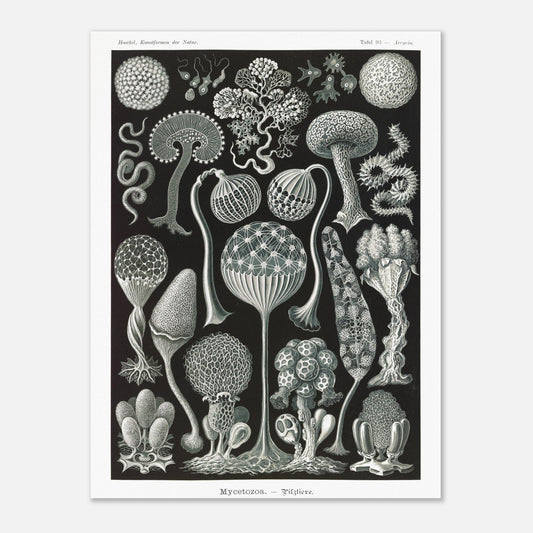Myxomycetes - Aesthetic illustration of the natural world - Ernst Haeckel, Kunstformen der Natur
Myxomycetes - Aesthetic illustration of the natural world - Ernst Haeckel, Kunstformen der Natur
Couldn't load pickup availability
Reproduction engraving of: Myxomycetes
Original title Mycetozoa - Pilztiere
Poster of Arcyria - Protozoa of the main class Rhizopoda (Rhizopoda), Class Mycetozoa (Mycetozoa)
Illustration from the book Kunstformen der Natur, which is a collection of artistic lithographs of natural sciences published by the German biologist Ernst Haeckel between 1899 and 1904.
This naturalistic illustration is part of an overall style inspired by Ernst Haeckel, which greatly influenced the emerging Art Nouveau movement at the beginning of the 20th century. This work, illustrating the impressive beauty and great diversity of the biological world, was complemented by a certain amount of scientific information, some excerpts of which are reproduced below.
This information is over 120 years old and some of it may be outdated!
Scientific classification:
Phylum Protozoa Main class Rhizopoda (Rhizopoda) Class of Myxomycetes (Mycetozoa)
Scientific notice (extract) accompanying the poster print of Mycetozoa - Myxomycetes :
The strange organisms, which modern zoologists refer to as Mycetozoa, were generally considered plants by botanists only fifty years ago, and classified as a separate order within the class of Fungi (Mycetes, Plates 63 and 73). It was not until 1858 that the previously unknown embryonic history of these organisms was completely elucidated, revealing that they have nothing to do with true fungi, but rather belong to the main group of Rhizopoda among the Protozoa; here they form a separate class (over 300 species). All Mycetozoa are terrestrial organisms, developing mainly on decaying plant parts (rotten wood, old tree bark, rotting leaves); they feed like plasmophages on the decaying substances of these materials (saprophytes). They pass through several very different states during their life cycle; In the active and motile state (kinesis), they form naked plasma bodies, which they move like other Rhizopods, ingesting food and growing considerably (Fig. 1-3). In a second state, the vegetative state (plasmodium), the changing plasma bodies have grouped together in a simple, often spherical or oval mass, called a sporangium (Fig. 4-20); this is filled with thousands of small germ cells or spores. During the germination of Mycetozoa (in water), a small naked germ cell emerges from each closed spore (Fig. 1, bottom); this soon produces a fine filament of plasma and moves by swimming in the water thanks to this flagellum. But soon these swimming spores (Fig. 1) retract their flagellum and transform into crawling amoebas, that is, naked cells with a single nucleus, similar to ordinary amoebas, which slowly change shape (Fig. 2). When several of these nucleated amoebas fuse, they form larger plasmoids, often several centimeters in size (Fig. 3). Most of the time, they form a fine network with irregular meshes, in perpetual slow transformation; their living plasma shows no distinct structure, but forms a viscous, gelatinous mass, often white or yellow in color. When the growing plasmoid reaches a certain size, it contracts into a compact, round mass, secretes a hard outer envelope (peridium), and divides into thousands of small flagellated spores, each with a cell nucleus. From the network of filaments between the spores, a network of fine fibers (capillitium, Fig. 8-9) develops. Later, when the white fruiting capsule (often on a stem) opens, the elastic capillitium escapes from the cracked peridium and spreads the spores (Fig. 10-20).
Species present on the Myxomycetes - Arcyria naturalist board :
- Arcyria punicea
- Trichia varia
- Physarum plumbeum
- Badhamia panicea
- Didymium nigripes
- Didymium farinaceum
- Lepidoderma tigrinum
- Trichia fragilis
- Arcyria serpula
- Dictydium cernuum
- Cribraria aurantiaca
- Cribraria intricata
- Cribraria pyriformis
- Trichia verrucosa
- Arcyria cinerea
- Stemonitis fusca
- Physarum didermoides
- Arcyria incarnata
- Trichia botrytis
- Arcyria adnata
About this print
About this print
The layout and composition of this reproduction have been the subject of our greatest attention.
- Respect for the format of the original work: in order to faithfully transcribe the artist's intention, the work is not cropped/re-cut except in extreme cases (obvious imperfection, geometry problem, etc.) in which case the cropping will be as light as possible.
- The presence of white margins is sometimes necessary in order to present the work in a balanced manner.
- Each size offered has been specifically composed, therefore, the size of the white margins may vary from one print size to another. Remember to check this detail carefully!
- Print only, frame not included!
Features
Features
- Premium 200gsm matte white paper, durable and strong.
- Natural, smooth uncoated finish, silky to the touch
- FSC certified paper or equivalent certifications depending on regional availability.
- Each print is shipped in sturdy packaging, ensuring safe transport.
- Each print is printed and shipped on demand. No minimum order quantity is required.
Share !









Recently viewed products
We are listening to you
If you are looking for a specific composition, a particular layout, or any other customization need, our team is at your disposal and will do everything possible to meet your requests.
So don't hesitate to...




